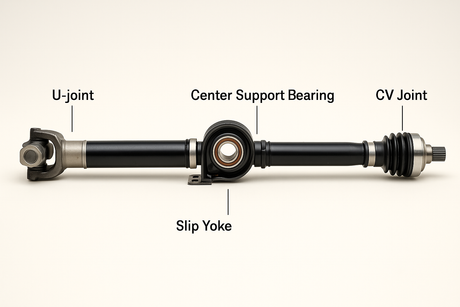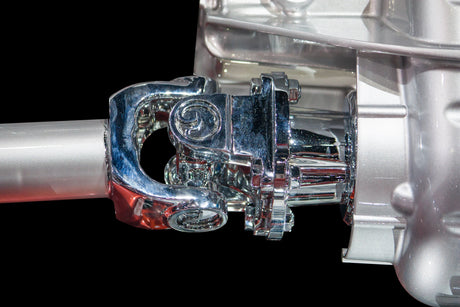The driveshaft is one of the most critical components of a vehicle's drivetrain, yet it's often misunderstood. Myths and misconceptions about driveshafts can lead to improper maintenance, unnecessary repairs, and even vehicle damage. In this article, we'll debunk some of the most common driveshaft myths and provide factual, practical advice for automotive professionals and DIY enthusiasts.
Myth 1: Driveshafts Never Need Maintenance
The Truth: Driveshafts do require regular maintenance to ensure optimal performance and longevity.
What You Should Do:
- Inspect Regularly: Conduct visual and physical inspections for signs of wear, rust, and damage. Look for any dents, cracks, or corrosion along the shaft.
- Lubricate U-Joints: Utilize high-quality grease designed specifically for U-joints. Make it a part of your regular vehicle service routine.
- Balance Checks: Have your driveshaft balance checked by a professional, particularly if you notice persistent vibrations while driving.
Myth 2: All Vibrations Are Caused by Imbalance
The Truth: While imbalance can cause vibrations, other factors like worn U-joints, misalignment, or even tire issues can also be culprits.
What You Should Do:
- Comprehensive Diagnostic: Use specialized diagnostic tools such as vibration analyzers, dial indicators, and laser alignment tools to accurately diagnose the root cause.
- Check Other Components: Don’t overlook other possible sources like tires, wheels, and suspension parts. A systematic approach can help isolate the problem.
Myth 3: One Size Fits All
The Truth: Driveshafts must be precisely sized and aligned to work correctly.
What You Should Do:
- Measure Accurately: Use precision measuring tools to determine the correct length, diameter, and other specifications required for your specific vehicle.
- Manufacturer Specifications: Always consult and follow the vehicle manufacturer’s guidelines and recommendations for driveshaft sizes and types. Using the wrong size can severely impact vehicle performance and safety.
Myth 4: Driveshaft Issues Are Always Obvious
The Truth: Some driveshaft issues can be subtle and go unnoticed until they cause significant damage.
What You Should Do:
- Listen for Clues: Pay attention to any unusual noises such as clunks, clicks, or hums. These noises are often early indicators of driveshaft issues.
- Regular Inspections: Even in the absence of obvious symptoms, conduct regular, thorough inspections to catch potential problems before they escalate. Use a flashlight and inspection mirrors to examine hard-to-see areas.
Myth 5: You Can Ignore Minor Issues
The Truth: Minor driveshaft issues can escalate quickly, leading to major problems like complete drivetrain failure.
What You Should Do:
- Address Promptly: Treat even minor signs of wear or discomfort seriously and address them immediately. Delay can lead to more complex and expensive repairs.
- Preventive Maintenance: Implement a regular maintenance schedule. Keep a log of inspections, services, and replacements to track the driveshaft's condition over time.
Myth 6: Only Professionals Can Service Driveshafts
The Truth: While some aspects of driveshaft maintenance are complex, many tasks can be performed by knowledgeable DIY enthusiasts.
What You Should Do:
- Educate Yourself: Invest time in learning. There are plenty of online resources, forums, and workshops specifically for driveshaft maintenance.
- Invest in Quality Tools: Assemble a toolkit that includes torque wrenches, lubricants, alignment fixtures, and other essentials.
- Know When to Seek Help: Understand your limitations. Tasks requiring specialized equipment or advanced knowledge should be left to professionals, especially if it involves safety-critical components.
Understanding and debunking common driveshaft myths is crucial for both automotive professionals and DIY enthusiasts. Proper driveshaft maintenance ensures optimal vehicle performance, safety, and longevity. Regular inspections, accurate diagnostics, and preventive care are key to avoiding unnecessary repairs and costly damage.
By staying informed and proactive, you can keep your driveshaft—and your vehicle—running smoothly. Whether you're performing a simple U-joint lubrication or diagnosing complex vibrations, the right knowledge and tools can make all the difference. Remember, the best way to safeguard your vehicle’s drivetrain is through regular, comprehensive maintenance and addressing issues promptly.
If you found this article helpful, check out our other automotive maintenance guides and tips. For more detailed information on specific driveshaft services, feel free to explore our resources or consult with a professional. Keep your vehicle in top shape and drive with confidence knowing you’re equipped to handle driveshaft challenges effectively.
Stay tuned for more expert advice and tech tips on automotive care. Subscribe to our newsletter to never miss an update on the latest in automotive maintenance and repair.






